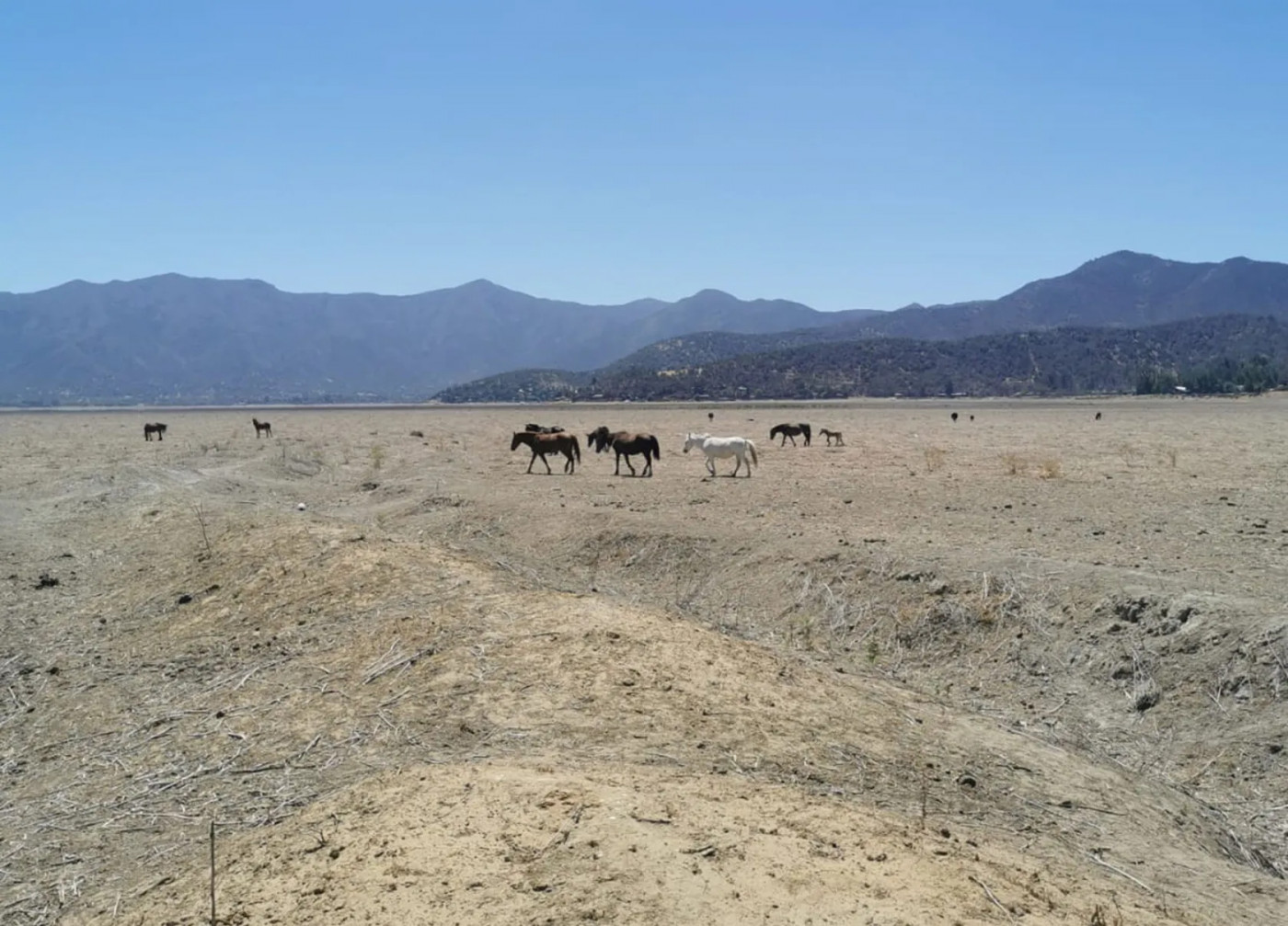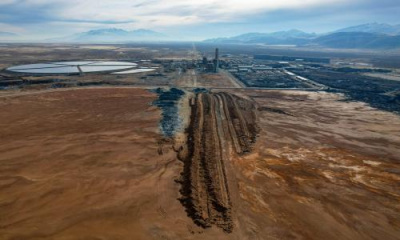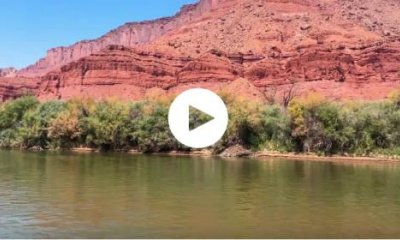Back in its heyday, the shoreline of the Great Salt Lake boasted multiple resorts offering dining, dancing, concerts, picnic pavilions, a bowling alley. Thousands swarmed these resorts for entertainment and to take advantage of the natural buoyancy of its salt-filled waters.
There was even a steamboat securely moored to a 400-foot pier offering a restaurant and recreation hall. It was named the General Garfield after U.S President James Garfield, a former Civil War general who cruised around the lake.
With the exception of Saltair, those amenities are gone.
At its height, Lake Aculeo — 5,810 miles from the Great Salt Lake and in South America’s Chile — attracted people from nearby Santiago and the surrounding area to enjoy sailing, boating and swimming in its fresh waters that occupied a surface area four times the size of New York City’s Central Park.
All that is gone. In fact, like the Great Salt Lake’s surface that has been reduced by more than half and its volume diminished by 64% as of 2019, Lake Aculeo began to shrink during a drought.
In May 2018, Lake Aculeo dried up completely. Now researchers, the Chilean government and its prior users are scrambling for ways to rectify the problem, including exploring the idea of a pipeline to bring water in from another basin and curtailment of consumptive use.
A dust storm whips up in January 2022 at the former Lake Aculeo in Chile. The lake completely dried up in May 2018 due to drought, overpumping of groundwater, rapid population growth and agricultural as well as urban diversions. It serves as a cautionary tale for the dwindling Great Salt Lake.
A tale of two lakes
Will Munger is a 33-year-old doctoral student in Utah State University’s Department of Environment and Society who spent January of this year in Chile documenting the demise of Lake Aculeo.
He was in Chile as part of the PATHWAYS Program, a research effort funded by the National Science Foundation that taps young scientists in both North America and South America to use Lake Acuelo as a case study for slow-moving ecological disasters. The fellowship is led by the University of New Mexico and Washington State University.
Dubbed the Transect of Americas, the initiative has scientists like Munger examining the desiccation of lakes in the Americas or the threat of a lake drying up.
Unlike the salty Great Salt Lake, Lake Aculeo was an important source of drinking water for area residents.
It now is a rangeland pasture for horses, and its wide variety of human uses are a memory.
Munger said while he was there he felt an amplified connection to the Great Salt Lake.
“I guess the biggest surprise was just how similar some of the challenges facing management of these systems are,” he said. “There’s no easy answer for the Great Salt Lake or Lake Aculeo. In fact, hydrologists and engineers working on that system sometimes disagreed about what the causes and drivers were, but the reality is both lakes are facing existential crises that have huge implications for human health, the economy, the environment.”
Why is saving the Great Salt Lake important? Consider its $1.3 billion contribution to Utah’s economy, its support of multiple industries, a vibrant ecosystem that attracts millions of birds and the health risk of dried lake bed with toxin-laden dust.
While there, Munger and the research team observed dust tornadoes whipped up by the wind that threatened adverse health impacts to both lungs and cardiovascular systems.
Similarly, the drying of Owens Lake in California caused the nation’s worst concentration of PM10 pollution, leading to an effort that so far has cost $2.4 billion to try to address — and regulators are not there yet.
With the dwindling Great Salt Lake, more than 800 square miles of lake bed have been exposed and the northern Wasatch Front is already witnessing lake-induced dust storms.
A dust storm a year ago in February led to unhealthy PM10 levels in the northern Wasatch Front. Studies say approximately 40% of that “urban” dust is coming off the lake. That percentage of dust goes up dramatically when desert basins are included.
Horses graze on the former Lake Aculeo southwest of Santiago, Chile, in January 2021. The lake completely dried up in May 2018 due to drought, overpumping of groundwater, rapid population growth and agricultural as well as urban diversions. It serves as a cautionary tale for the dwindling Great Salt Lake.
Will Munger
What happened to Lake Aculeo?
Munger said the circumstances of its drying in many ways, but not all, mirror what is happening to the Great Salt Lake.
He pointed to extreme drought, excessive diversions from farmers and an exploding population, unregulated groundwater pumping, and lack of public science on water as well as a lackluster approach to water management.
Munger said many of the water systems became privatized over the years, with no real accountability or managerial oversight.
“The one thing I realized during my time there was the real difference of having publicly funded water science available. For instance, we have the U.S. Geological Survey that does some really extensive measuring of our river systems and groundwater systems. And that sort of public science was not present, and there was real frustration from my Chilean colleagues that there hasn’t been that type of institutional support.”
In Chile, there was also a lack of priority to rehabilitate the lake’s tributaries and improve the health of riparian systems.
Researchers document a dust storm on the former Lake Aculeo in Chile in January 2022. The lake completely dried up in May 2018 due to drought, overpumping of groundwater, rapid population growth and agricultural as well as urban diversions. It serves as a cautionary tale for the dwindling Great Salt Lake.
Will Munger
Warning signs Chile ignored
Like the North American West, central Chile and the Santiago area have been in the throes of a historic drought, with the National Aeronautics and Space Administration reporting that since 2010, average annual rainfall has been reduced by 25% to 45%.
Chilean scientists say half the lake’s water loss was due to drought while the rest was attributed to irrigation and population growth.
As an example, the nearby community of Paine increased its population by 45% between 2002 and 2017, according to statistics from Chile’s National Statistics Institute and reported by NASA.
High water demands put stress on the system, the decrease in rainfall affected aquifer recharge and groundwater pumping continued unabated, which would have been sustainable under normal hydrological conditions — but those conditions were anything but normal.
Research put out in 2020 by the University of Arizona says those groundwater withdrawals should have been adjusted considering the drought and increased demand by growing populations.
The Arizona research recommended an extensive remediation and mitigation plan for the lagoon that if implemented would cost $10 million in U.S. dollars.
Munger said that has yet to happen.
In a detailed story on water scarcity in Chile and put out by Geneva Solutions, an independent, international network focused on solutions journalism, writer Michelle Langrand noted adoption of a 1980 constitution that created a unique water market that allowed users to claim water on their land and hold water rights in perpetuity.
Agriculture, mining and other economic industries have sucked up the water to such an extent, Chile will be at the top of the list of countries that will be facing high water stress by 2040. She writes that 1.4 million people, about 8% of Chile’s population, don’t have access to drinking water or sewage, and rural communities are left to battle it out with large companies for water.
Chile is looking to revamp its constitution, and under consideration is guaranteeing access to water as a “human right.”
Like Lake Aculeo, which was burdened by diversions, the Great Salt Lake has suffered those same impacts since pioneers first arrived in Utah and those pressures continue to this day. A white paper released in 2016 detailed a drop in the lake levels by 11 feet since 1847. Those diversions have continued, with the lake dropping to a historic low last October.
Munger, citing other sources, said consumptive water uses in the Great Salt Lake watershed have depleted inflows by approximately 39%, with 63% used by agriculture, 11% by cities, 13% by solar ponds, and 13% by other uses.
There is also pressure for more diversion with the state’s proposed Bear River Development project to tap 222,000 acre-feet of water. The state asserts via return flows, the system would take a fraction of that — 85,600 acre-feet.
That project, once envisioned to be necessary by 2015, has been put off until at least 2045 because of conservation achievements.
Will Munger, a doctoral student in Utah State University in the Department of Environment and Society, poses for a photo along Emigration Creek in Wasatch Hollow Preserve in Salt Lake City on Friday, April 15, 2022.
Utah’s approach compared to Chile
Unlike Chile, water rights are not held on a permanent basis in Utah. They can be forfeited if not put to beneficial use after seven years and then they revert to the public. Junior water rights holders can have their access curtailed if surface water is greatly diminished.
In 2015, the state engineer who oversees water rights put a “call” on the Virgin River in southern Utah because it was so dry. That cut off access to utilize junior water rights.
In Utah, water “belongs” to the people of the state — unlike Chile — and lawmakers recently passed a law outlining a study on ways to prioritize drinking water and public safety should there be an extreme water shortage.
Groundwater pumping in Utah is also regulated to a greater extent than in Chile.
Jim Reese, assistant state engineer, said in 2006 a provision in state law was enacted to direct the development of groundwater management plans in a defined groundwater basin area. The idea was to set up a strategy for “safe yield” withdrawals that would not jeopardize groundwater recharge.
If an issue arises, the state engineer has the ability to prevent so-called groundwater mining and curtail the rights of certain users.
There is more to learn about groundwater science, to be certain; hence the recent launch of a Great Salt Lake groundwater study by the U.S. Geological Survey.
A bitter water right battle over proposed groundwater pumping is brewing in central Utah because critics say what happens in one basin affects the hydrological resources in another, at that ultimately, these aquifers support the Great Salt Lake. The permitting federal agency, even though one county has secured the water rights, will conduct studies to see if the groundwater pumping is sustainable. There was not that sort of robust oversight in Chile.
Additionally, Utah has a Great Salt Lake coordinator and in 2013 adopted a Great Salt Lake management plan. For years, there has existed the Great Salt Lake Advisory Council and there are multiple advocacy organizations.
Multiple scientific studies have been commissioned over the years to highlight challenges, in contrast to Chile where once again, Munger stressed there was little public science on the lake.
Lynn de Freitas, executive director of Friends of the Great Salt Lake, told a legislative committee earlier this year that there has been a long overdue sea change this session when Utah lawmakers enacted many Great Salt Lake bills that include:
- Creating a $40 million trust tapping the expertise of a qualified nonprofit to enact solutions such as the acquisition of water rights and restoration of tributaries to benefit the Great Salt Lake.
- Allowing the Utah Division of Forestry, Fire and State Lands to acquire water rights as the owner of the lake bed, essentially recognizing that the Great Salt Lake represents a beneficial use of water.
- Allowing farmers to temporarily lease their water rights to the benefit of the Great Salt Lake.
- Directing the development of an integrated assessment of the Great Salt Lake Watershed, which is more than 21,000 square miles.
Munger said he does see some evidence of collaboration in Chile that may help.
In the Laja Basin in Chile, which hosts a lake, there’s been a collaboration involving farmers, ranchers, scientists and community members who are embracing strategies to better understand the challenges.
“They have kind of turned the corner,” Munger said.
He added he believes a similar corner is being turned in Utah.
“Another really important part of this story is that of collaboration. You’ve got to bring a lot of different people to the table and work it through. Maybe we all have slightly different interests, but I think in Utah, we all have this common interest in stewarding the future of the Great Salt Lake. I think it was amazing the consensus we saw at the legislature across the political spectrum and so we know there are solutions out there.”
Munger said continued collaboration is key.
“We’re all in this together.”









